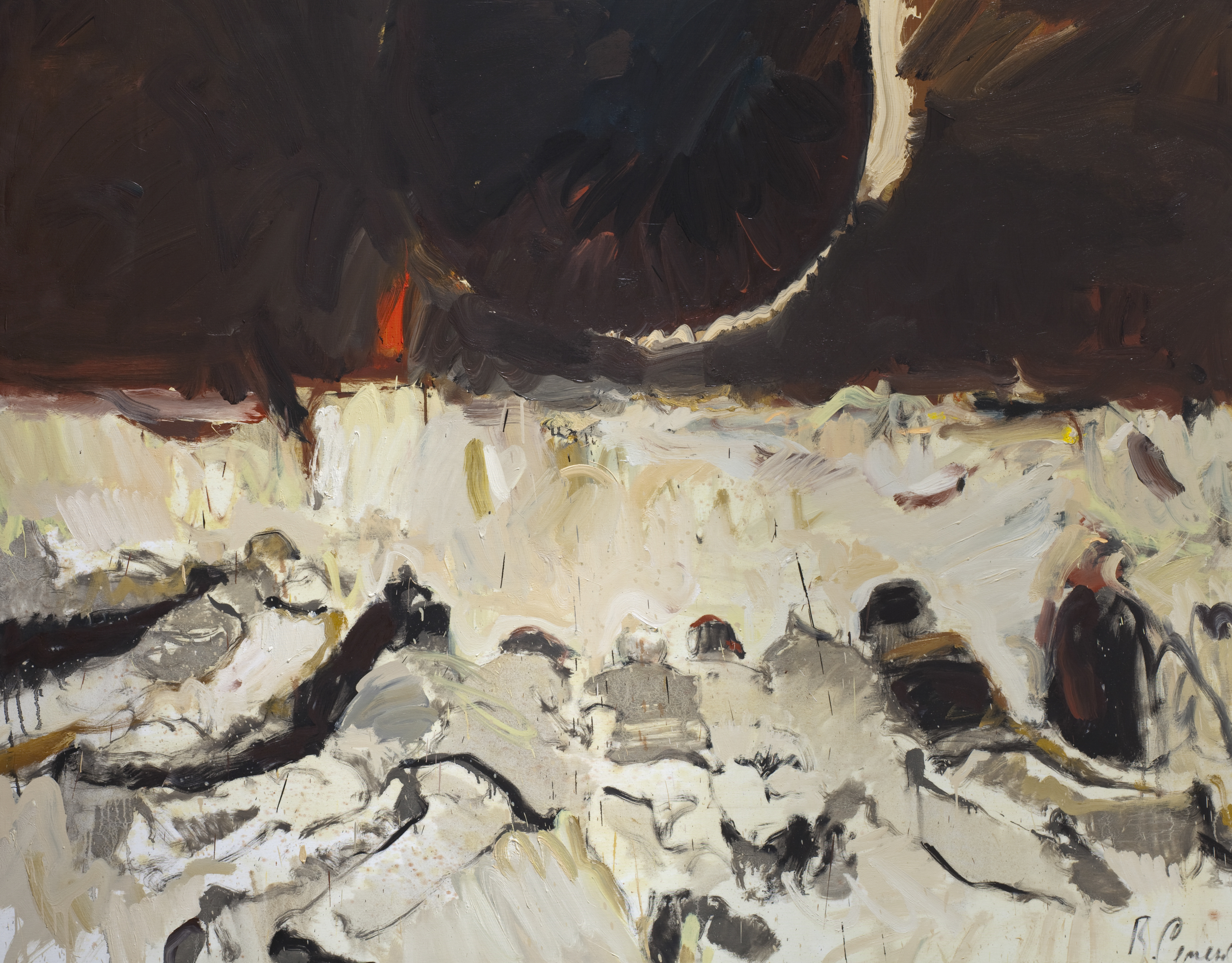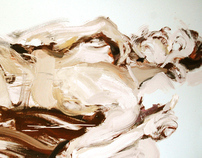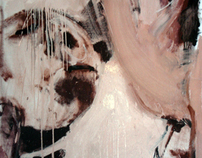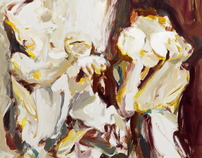Vladimir Semenskiy does large canvas paintings, showing reality as a randomsum of spontaneous personal movements. Painting itself is formed of spontaneous bodily movements and presents them as the closest reality and simultaneously the closest secret of which they are born. His painting is corporeal and speaks of the body, which is put together from unpredictable inner movements. It is distinguished by chaotic frankness and eurythmy. It is both intimate and eccentric. It grows out of a runaway and intuitive spirit and speaks of freedom as an indispensable prerequisite for the emergence of man.
The children painted by Vladimir Semenskiy, or the kindergarten, which he observes from without, the garden of continuous natural flourishing and development are, of course, not merely concrete personages or a poetical metaphor determining the content of a concrete exhibition. Be it a portrait or figure, it is a vacant shape, nearly an icon-painting formula, which is filled with actual moving and living materiality of painting. Shapes are filled notwith a ready-made text, but with the material of which the text is assembled, the language per se and the raw material of art. Man appears in that language, in painting, not as an abstraction or generalization, but as an instant of the unpredictable and disorderly chaos of manifestation, of something rather vaguethat forms part of individual personal experience, of what we call humaneness.
Semensky's paintings abound in light vanishing meanings and always rest on personal unobjectivized links and codes - a classical material for a plastic composition at times looking more like dancing than drawing. Painting with Semenskiy is an action that boils down to establishing a brief and direct link with reality. The substance of that link is the meaning of an artwork.
The artist discovers painting as the language and form of that link, or rather painting makes that link obvious. Painting amounts to the understanding of the physics of the world, which man needs primordially, even if he is not quite aware of it. All things in the world, all its components are interrelated, and this relationship is seen in their plastic movements. This eurythmy becomes a pictorial form: it dictates its structure and gives birth to pictures. Streams that become color envelop bodies and fixate them in the world, making them visible. They seem to make real people gesticulate the way they do, act the waythey do and say the things they say. For an instant the unstable unity of the universe takes shape and is captured on canvas. Semenskiy makes the direction and duration of inner bodily movements visible, the movements of bodies that make up space, which he scrutinizes and in doing so discovers the need to work with the language of painting.
Semenskiy's works show clearly that the artist wants to trace the intricate movements of the world, which reveals itself to man who sees it as slipping away, hiding and needing painting in order to appear. This is because every event, every natural movement is simultaneously a movement of man, be it initial or reciprocal. People, too, appear through movement: both in art and in their own life stories they appear in their near critical, as if absolutely 'human'states.
This language has its own geometry, the geometry of the trajectories of thefree form-building movement of color. These forms are always unstable and mightbe called accidental had they not been conditioned by the essential nature ofcolor, that is, light itself that creates the forms of life.
Painting is again emerging as an important language of culture in the contemporary world. It preserves and recovers in real time meanings that have disappeared or been removed from other languages of art. This means that paintingis highly valuable nowadays. Meanings are responsible for the value of culture. Art is valuable in as much as it creates the ever living and developing space in which man sees the world, being born and created every instant, and in it - himself creating an image of that world and returning it to reality in response to the world's appearance to man.
Alexander Balashov
The children painted by Vladimir Semenskiy, or the kindergarten, which he observes from without, the garden of continuous natural flourishing and development are, of course, not merely concrete personages or a poetical metaphor determining the content of a concrete exhibition. Be it a portrait or figure, it is a vacant shape, nearly an icon-painting formula, which is filled with actual moving and living materiality of painting. Shapes are filled notwith a ready-made text, but with the material of which the text is assembled, the language per se and the raw material of art. Man appears in that language, in painting, not as an abstraction or generalization, but as an instant of the unpredictable and disorderly chaos of manifestation, of something rather vaguethat forms part of individual personal experience, of what we call humaneness.
Semensky's paintings abound in light vanishing meanings and always rest on personal unobjectivized links and codes - a classical material for a plastic composition at times looking more like dancing than drawing. Painting with Semenskiy is an action that boils down to establishing a brief and direct link with reality. The substance of that link is the meaning of an artwork.
The artist discovers painting as the language and form of that link, or rather painting makes that link obvious. Painting amounts to the understanding of the physics of the world, which man needs primordially, even if he is not quite aware of it. All things in the world, all its components are interrelated, and this relationship is seen in their plastic movements. This eurythmy becomes a pictorial form: it dictates its structure and gives birth to pictures. Streams that become color envelop bodies and fixate them in the world, making them visible. They seem to make real people gesticulate the way they do, act the waythey do and say the things they say. For an instant the unstable unity of the universe takes shape and is captured on canvas. Semenskiy makes the direction and duration of inner bodily movements visible, the movements of bodies that make up space, which he scrutinizes and in doing so discovers the need to work with the language of painting.
Semenskiy's works show clearly that the artist wants to trace the intricate movements of the world, which reveals itself to man who sees it as slipping away, hiding and needing painting in order to appear. This is because every event, every natural movement is simultaneously a movement of man, be it initial or reciprocal. People, too, appear through movement: both in art and in their own life stories they appear in their near critical, as if absolutely 'human'states.
This language has its own geometry, the geometry of the trajectories of thefree form-building movement of color. These forms are always unstable and mightbe called accidental had they not been conditioned by the essential nature ofcolor, that is, light itself that creates the forms of life.
Painting is again emerging as an important language of culture in the contemporary world. It preserves and recovers in real time meanings that have disappeared or been removed from other languages of art. This means that paintingis highly valuable nowadays. Meanings are responsible for the value of culture. Art is valuable in as much as it creates the ever living and developing space in which man sees the world, being born and created every instant, and in it - himself creating an image of that world and returning it to reality in response to the world's appearance to man.
Alexander Balashov




